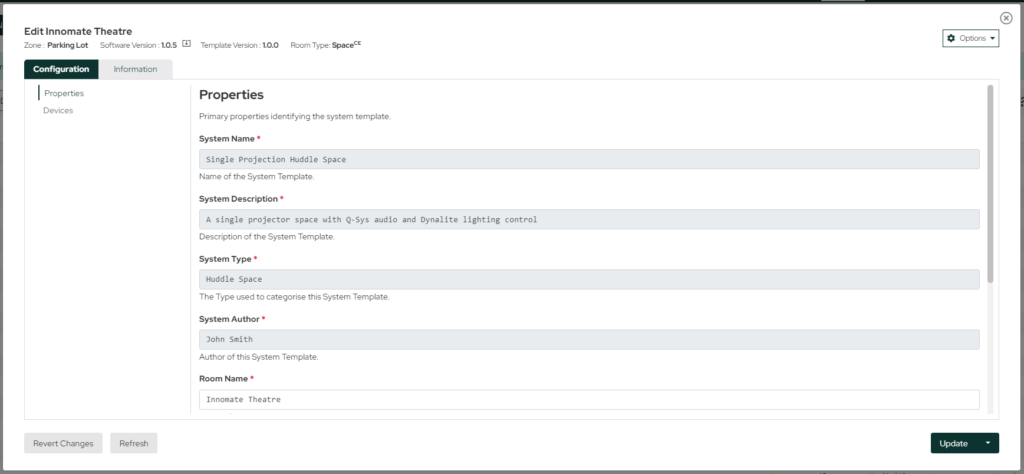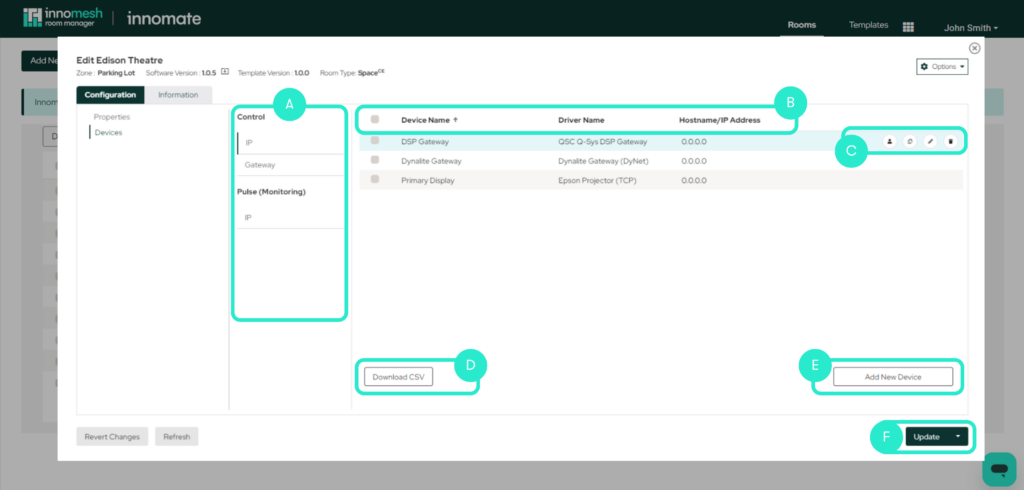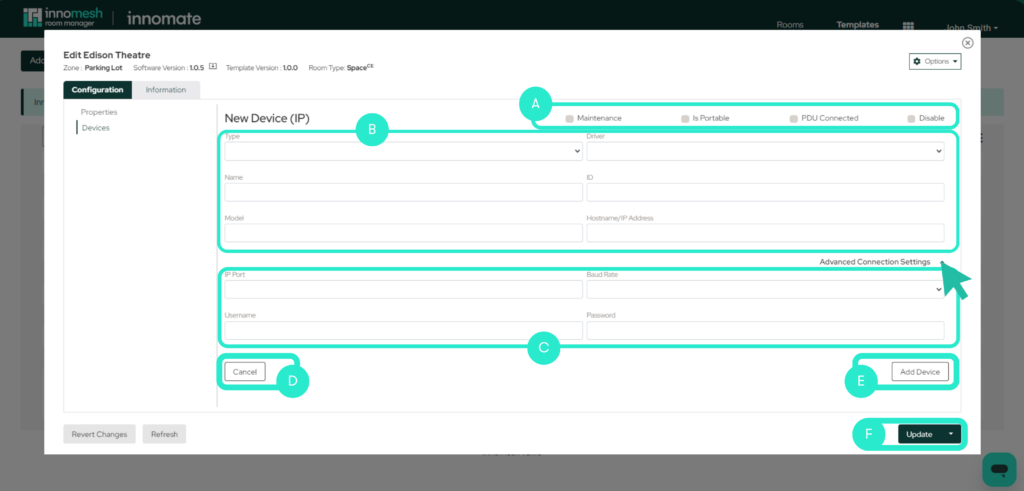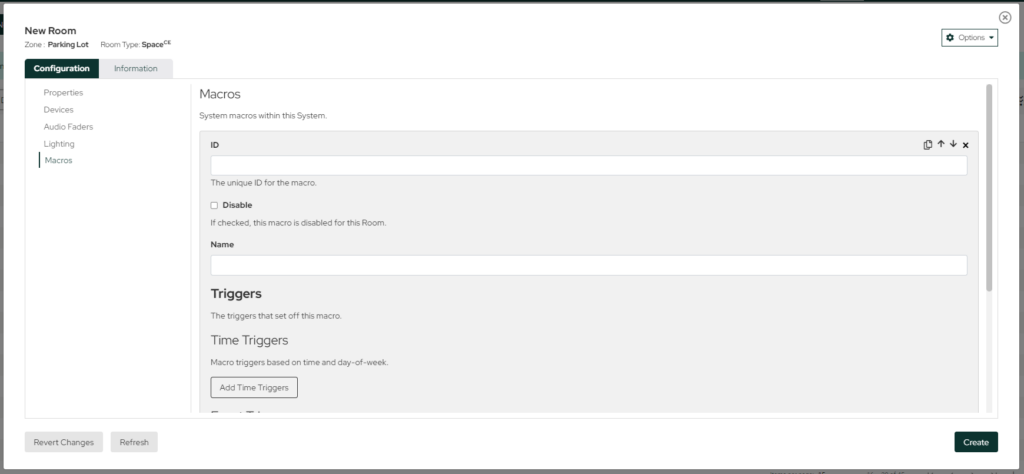Introduction
Within SpaceCE, a room is created from a system template. However, unlike SpaceVC, SpaceCE rooms are not as intricately tied to system templates. For example, updating system templates will not automatically update rooms, and the SpaceCE software version of the room can also deviate from that of the template.
However, to ensure uniformity and ease of maintenance across an environment, it is always recommended that rooms are kept in sync with their system templates. For this reason, Innomesh will flag cases where a room is out of sync with its system template, both in its software version and in the system template version deployed against it.
Configuration Options for an SpaceCE Room
The configuration options available for your SpaceCE room are dependent on the SpaceCE software you are using. However, all SpaceCE rooms share the below configuration options:
- Properties
- Devices
- Macros
The below section provides an overview of each of these configuration options.
Properties

The configuration options under “Properties” are general information related to a room, and include the following:
Template Version
The version of the System Template this room is deployed against.
Room Name
The friendly name of the room.
Room Repository Name
This is auto-populated based on the Room Name, and is the global identifier of the room.
Room Author
The author of this room configuration. This is automatically pre-populated with the name of the user creating the room.
In Maintenance
This is used to marks rooms that are “in maintenance”, e.g. rooms that are under construction or is being refurbished, and are not fully operational. Marking a room as “in maintenance” results in all alerts for the room automatically diverting to the “Suppressed Alerts” tab on the Portal Hotlist.
For more information, please refer to this link.
Is Portable
If enabled, this room is regarded as a portable room, and any alerts arising from connectivity or communication issues to this room’s devices are diverted to the “Suppressed” tab on the Portal Hotlist.
For more information, please refer to this link.
Devices
Main View

In the main device view we can see 5 primary sections.
A. Types of Device
Devices are separated into 2 categories, selectable on the centre column:
- IP
- Gateway
Pulse (Monitoring) can be included in this template.
B. Device Fields
Fields which describe the key properties of a device, such as name, gateway name etc.
Depending on the type of device being created, these fields will be different.
C. Information, Duplicate, Edit and Delete
These allow a device to be populated with its information, duplicated, edited and deleted. The Edit button in particular will take users to a detailed view of the device, allowing for further customisation if required.
D. Download as CSV File
This button download the current list of devices in this category as a CSV file.
E. Add New Device
This button allows the user to add a new device of the selected category.
F. Update
This option will allow you to update the Space CE in isolation from the Pulse Template, and vice versa.
“Add New Device” View
When adding a new device, the following fields are presented.

A. Maintenance, Is Portable, PDU Connected & Disable
In Maintenance
If checked, alerts from this device will be diverted to the “Suppressed” alerts list on the Innomesh Portal Hotlist. This feature can be used when a faulty device needs to physically disconnected for maintenance purposes.
Is Portable
If checked, alerts from this device will be diverted to the “Suppressed” alerts list on the Innomesh Portal Hotlist. This featured can be used if the device is portable and is not always connected i.e. a display on a removable trolley.
PDU Connected
This denotes that the device is connected to a power distribution unit (PDU), and only turns on while the room is powered on. If checked, alerts from this device be diverted to the “Suppressed” alerts list on the Innomesh Portal Hotlist while the room is powered off.
Disable
If this button is checked, the device will be disabled from the configuration.
B. Standard Fields
Fields which describe the key components of a device.
Depending on the type of device being created, these fields will be different. Fields that are common to all types of device are Device Name, Driver and ID. This will be discussed in greater detail below.
C. Advanced Connection Settings
This is an expandable menu which shows advanced connection settings relevant for this device type. It is hidden by default.
D. Cancel
This undoes all changes made to this device configuration and returns you to the Device main view page.
E. Add Device
Once all of the required fields are input, this adds the device to the room configuration.
F. Update
This option will allow you to update the Space CE in isolation from the Pulse Template, and vice versa.
Common Elements to all Device Types
As previously mentioned, each type of device will have different fields which the user must enter.

ID
The unique identifier for the device. This is automatically populated depending on the device type selected.
Name
The friendly name for the device.
Driver
The driver which SpaceVC uses to connect to and control the device.
IP Devices
- Type – The device type e.g. Camera or Projector.
- Driver – The driver which spaceVC uses to connect to and control the device.
- Name – The ‘friendly name’ for the device.
- ID – The auto-generated unique identifier for the device. For e.g. dev.display.1.
- Model – The Model of the device.
- Hostname/ IP Address – The hostname or IP address of the device.
Advanced settings –
- IP Port – The IP port for connecting to the device, if different from the device default.
- Baud Rate – The baud rate for controlling the device.
- Username – The username required (if any) to connect to the device.
- Password – The password required (if any) to connect to the device.
Gateway Devices

- Type – The device type e.g. Audio Fader.
- Driver – The driver which spaceVC uses to connect to and control the device.
- Name – The ‘friendly name’ for the device.
- ID – The auto-generated unique identifier for the device. For e.g. dev.display.1.
- Gateway Device ID – The ID of the IP device through which this device communicates.
Macros

This array element contains the definitions for any macros. Macros are a series of custom actions, definable as a lambda script, that are set off by a trigger. Triggers can either be based on an event (e.g. when the system powers on), or on time and day of week.
The definition for macros consists of the following elements:
ID
The unique identifier for the macro. It is recommended that this be defined in the following format: macro.trigger.[device].operation. For e.g. macro.poweron.1.
Disable
If set to true, this macro is ignored in the configuration.
Name
The friendly name for the device.
Triggers / Time Triggers
This array element defines the one or more time-based triggers that set this macro. The array consists of the following elements:
ID
The unique identifier for this trigger.
Disable
If set to true, this trigger is ignored in the configuration.
Time
The 24-hour time, in the format HH:mm:ss, at which the macro is to trigger. This is relevant for “Time” triggers only.
Days
A comma separated list of days of the week on which the macro is to trigger. Also This is relevant for “Time” triggers only.
Example values are:
“Monday, Tuesday, Thursday”.
“Weekday” (Monday to Friday)
“Weekend” (Saturday or Sunday)
Triggers / Event Triggers
This array element defines the one or more event-based triggers that set this macro. The array consists of the following elements:
ID
The unique identifier for this trigger.
Disable
If set to true, this trigger is ignored in the configuration.
Guid
The GUID of the object generating the event. Relevant for Event trigger types only.
Property
The object property this event relates to. Relevant for Event trigger types only.
Key
For Dictionary object properties, the key by which the property value is accessed. Relevant for Event trigger types only.
Index
For List object properties, the index by which the property value is accessed. Relevant for Event trigger types only.
Value
The property value which, if matched, triggers this macro. Relevant for Event trigger types only.
Actions
This array element defines the one or more actions that are set off when the trigger conditions are met. The array consists of the following elements:
ID
The unique identifier for this action.
Disable
If set to true, this trigger is ignored in the configuration.
Script
The script that defines the action.
Device ID
This is required when the device keyword is used within the lambda script, to specify the ID of the device it is to refer to. Device IDs are defined under Devices > IP > ID.
Delay
The delay, in seconds, between the macro trigger occurring, and the macro action being executed.
